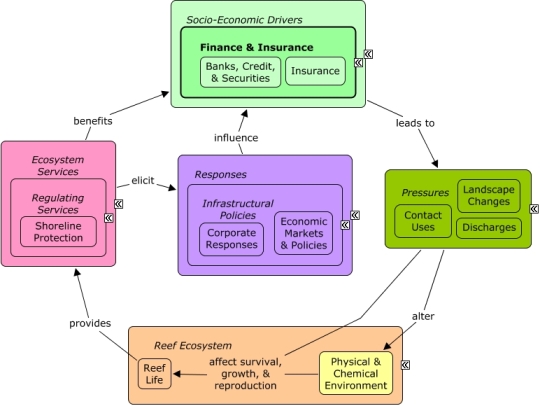ReefLink Database

Insurance
The insurance subsector includes brokers and agents engaged in selling annuities and insurance policies to pool risk, including health insurance, life insurance, and property insurance.
CMap

CMap Description
The Finance and Insurance sector can drive coastal development and contribute to landscape changes, including impervious surfaces, which alter rates of pollutant runoff, or to the need for physical changes to the coastline, such as shoreline armoring. Financial centers benefit from shoreline protection, particularly insurance companies, which are concerned with flood damage or erosion that put property and human lives at risk. Financial sectors also benefit indirectly from other ecosystem services that improve the well-being of sectors, such as tourism & recreation, which drive the overall economy. Corporate decisions and economic markets can influence how financial sectors distribute finances and set insurance rates.Citations
| Citation | Year | Study Location | Study Type | Database Topics |
|---|---|---|---|---|
| Gangai, J. W., R. Lenaburg, B. Batten, E. Drei-Horgan, N. Sheffner, D. Hamilton, M. Rezakhani, and P. Shrestha. 2008. Hurricane Flood Insurance study for the Hawaiian Islands. Pages 432-443 in Solutions to Coastal Disasters Congress 2008 - Proceedings of the Solutions to Coastal Disasters Congress 2008. | 2008 | US Pacific & Hawaii | Model; GIS & Maps; Decision Support Frameworks & Tools | Insurance; Military; Security Policies; Shoreline Protection; Storms & Hurricanes |
| Jordan, J. W. and S. L. Paulius. 2007. Lessons learned from Hurricane Katrina. Pages 43-58 in Forensic Engineering, Proceedings of the Congress. | 2007 | South & Central America; Mexico | Insurance; Shoreline Protection; Storms & Hurricanes |
Management Options
| Management Option | Description | Sources | Database Topics |
|---|---|---|---|
| Corporate Response: Develop Outreach with Shipping Businesses | This option requires the sanctuary to continue to alert shipping businesses about sanctuary regulations. Such regulations may include vessel waste discharge, ATBA, PSSA, etc. The targeted audiences will include importers, exporters, port authorities, commercial fishing companies, ship insurers. This information can be provided to the audience through NOAA nautical charts, trade publications, newsletters, trade shows, and direct mailings. | NOAA Marine Sanctuary Program. 2007. Florida Keys National Marine Sanctuary revised management plan. National Ocean Service, Key West, FL. |
Ballast Discharge; Boating Activities; Boating Regulations; Coastal Engineering; Collaboration & Partnering; Cultural Policies; Decision Support; Docks & Marinas; Environmental Education & Outreach; Finance & Insurance; Infrastructural Policies; Insurance; Manufacturing & Trade; Ports & Harbors; Shipping, Storage, & Warehousing; Transportation; Transportation Policies; Water Resources; Water Transportation; Waterborne Discharges |
| Restoration: Land Reclamation Integrating Landslide Treatments | This management option is exercised to prevent down slope movement of earthen materials, including natural soils, and spoil/waste from mining or forestry activities. Extreme caution and planning must be exercised before permitting any personnel, equipment or other machinery into the slide area. An experienced engineer should analyze the stability of the site both before and after alterations are made to evaluate stability. Water Control: sources of water that enter the area can be controlled to keep the material dry, as it is typically more stable when dry. Loading Control: where appropriate, consider removing excess material from upper portions of the slide area to reduce slide mass. Slope Reduction: where practice, use grading to reduce the slope of the slide area. Increasing Internal Strength: consider the impact of removing and recompacting of material at designed levels of moisture and with biotechnical slope stabilization practices. External Restraints: external restraints can be used where slope movements must be limited due to surrounding valued improvements (e.g. structures), where manipulation of the material may not achieve desired improvements. External restraints must be designed to prevent overturning, sliding at or below the base, and bearing failure of the foundation. Vegetative Treatment: deep rooted grasses and shrubs with proven performance in soil bioengineering applications can be planted using selected soil bioengineering or biotechnical slope stabilization techniques appropriate to the site. Transpiration and infiltration should be considered when choosing vegetation. | Natural Resources Conservation Service. 2011. National Handbook of Conservation Practices. U.S. Department of Agriculture. |
Agriculture, Aquaculture, & Forestry Policies; Construction Codes & Projects; Discharges; Ditching & Soil Disturbance; Forestry; Infrastructure; Insurance; Landscape Conservation & Restoration; Mining; Mining Policies; Non-point Source Runoff; Sediment |
Laws
| Legal Citation | Purpose of Law | Management Organization | Database Topics |
|---|
